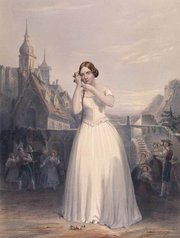 The Sleepwalker is an opera in two acts set in music by Vincenzo Bellini in the libretto I Felice Romani. The big composer wrote it in two months and, together with “The Puritan” and “Norma”, it is considered to be one of the most significant and classic of bellini. At the end of the first show, The Sleepwalker obtained a great success from the audience, the Italian and international theater scene for months and over the subsequent years. The libretto was written from “La Somnambule ou L’arrivée d’un nouveau signeur,” a ballet-pantomime by Eugéne Scribe and Pierre Aumer (1827), and from “La Somnambule,” comedy-vaudeville of the same Scrive and Germain Delavigne (1819), narrate the history of love between Amina and Elvino. The young amina, pure and pretty like the forested landscape in which the story takes place, loves Elvino profoundly and sincerely but suffers horribly when he becomes accused in an unjust fashion. The state of mind of Amina and of the desperate strength of her feelings confirm the music of the opera, where the divine orchestra often becomes a simple accompaniment to the voice of the singer, according to the philosophy of Bellini, always interested in the vocal aspect of the opera. The Bellinian melody, in fact, follows the Italian tradition of “bel canto” singing, allowing the music to adhere itself perfectly to the dramatic requirement and equilibrium and recitatives and the arias in a logical drama. Bellini did this to appear as a great composer to the eyes of his contemporaries like the heir of Rossinian music. The theme of regret for lost love is central in the opera and renders a lot of distressing arias of Amina when the musical interpretation is complex and expressive:
The Sleepwalker is an opera in two acts set in music by Vincenzo Bellini in the libretto I Felice Romani. The big composer wrote it in two months and, together with “The Puritan” and “Norma”, it is considered to be one of the most significant and classic of bellini. At the end of the first show, The Sleepwalker obtained a great success from the audience, the Italian and international theater scene for months and over the subsequent years. The libretto was written from “La Somnambule ou L’arrivée d’un nouveau signeur,” a ballet-pantomime by Eugéne Scribe and Pierre Aumer (1827), and from “La Somnambule,” comedy-vaudeville of the same Scrive and Germain Delavigne (1819), narrate the history of love between Amina and Elvino. The young amina, pure and pretty like the forested landscape in which the story takes place, loves Elvino profoundly and sincerely but suffers horribly when he becomes accused in an unjust fashion. The state of mind of Amina and of the desperate strength of her feelings confirm the music of the opera, where the divine orchestra often becomes a simple accompaniment to the voice of the singer, according to the philosophy of Bellini, always interested in the vocal aspect of the opera. The Bellinian melody, in fact, follows the Italian tradition of “bel canto” singing, allowing the music to adhere itself perfectly to the dramatic requirement and equilibrium and recitatives and the arias in a logical drama. Bellini did this to appear as a great composer to the eyes of his contemporaries like the heir of Rossinian music. The theme of regret for lost love is central in the opera and renders a lot of distressing arias of Amina when the musical interpretation is complex and expressive:
There is not one example when it is never evident that the celebrated “Ah, non credea mirarti,” in which the orchestra accompanies with out ever interfering with the painful song of the sweet amina before the unexpected happy ending. In the interpretation of Natalie Dessay that I have found here, it is possible to gather to perfection the diverse states of mind of the heroine of the opera that, in a state of sleepwalking, sings in a concerned and struggling fashion while the orchestra is gently inserted during the break in the singing, but then returns to solely the accompaniment of the voice; then, when the youth wakes up, the orchestra gaily anticipates the conclusion and Amina, with a series of virtuoustic trills that render participation in happiness of the onlookers. The strength of this splendid aria at the end of the opera is similar to l’incipit that was written in the tomb of Vincenzo Bellini, while the flower that the soprano Giuditta Pasta used to have if opening night (March 6, 1831) is still conserved today in a showcase in the Museum of San Pietro a Majella, at the Naples Conservatory.
This article has been translated into English by Elizabeth and Kati , students from Bard College. The original article is in Italian.







Commenti recenti